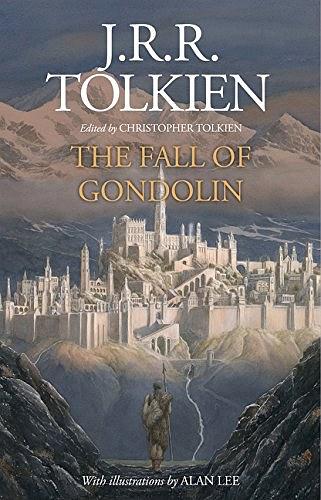In the Tale of The Fall of Gondolin are two of the greatest powers in the world. There is Morgoth of the uttermost evil, unseen in this story but ruling over a vast military power from his fortress of Angband. Deeply opposed to Morgoth is Ulmo, second in might only to Manwë, chief of the Valar.
Central to this enmity of the gods is the city of Gondolin, beautiful but undiscoverable. It was built and peopled by Noldorin Elves who, when they dwelt in Valinor, the land of the gods, rebelled against their rule and fled to Middle-earth. Turgon King of Gondolin is hated and feared above all his enemies by Morgoth, who seeks in vain to discover the marvellously hidden city, while the gods in Valinor in heated debate largely refuse to intervene in support of Ulmo's desires and designs.
Into this world comes Tuor, cousin of Túrin, the instrument of Ulmo's designs. Guided unseen by him Tuor sets out from the land of his birth on the fearful journey to Gondolin, and in one of the most arresting moments in the history of Middle-earth the sea-god himself appears to him, rising out of the ocean in the midst of a storm. In Gondolin he becomes great; he is wedded to Idril, Turgon's daughter, and their son is Eärendel, whose birth and profound importance in days to come is foreseen by Ulmo.
At last comes the terrible ending. Morgoth learns through an act of supreme treachery all that he needs to mount a devastating attack on the city, with Balrogs and dragons and numberless Orcs. After a minutely observed account of the fall of Gondolin, the tale ends with the escape of Túrin and Idril, with the child Eärendel, looking back from a cleft in the mountains as they flee southward, at the blazing wreckage of their city. They were journeying into a new story, the Tale of Eärendel, which Tolkien never wrote, but which is sketched out in this book from other sources.
Following his presentation of Beren and Lúthien Christopher Tolkien has used the same 'history in sequence' mode in the writing of this edition of The Fall of Gondolin. In the words of J.R.R. Tolkien, it was ‘the first real story of this imaginary world’ and, together with Beren and Lúthien and The Children of Húrin, he regarded it as one of the three 'Great Tales' of the Elder Days.
1、追日是作者栎年创作的原创作品,下载链接均为网友上传的的网盘链接!
2、相识电子书提供优质免费的txt、pdf等下载链接,所有电子书均为完整版!
-
蒋太的评论老托爷爷人间坑王,动不动就把写了一半或一个开头的故事abandon。他的救赎是小托爷爷,多亏这个好儿子,一生虔诚为父亲填坑,或至少把坑弄得不太像坑,结果就成了陷阱,进去了一样出不来。幸好刚多林受火攻而陷落,完整的版本还是有一个的,虽然全是倒装句。以及完全不记得金花喷泉他们的英勇事迹了,有机会复习真好。说起来,图奥的命比图林还是强得太多。然而最惨的其实是费诺的儿子们,摊上那么一个老爸太不幸了。
-
caterpillar的评论三大传说的结局:小强生生把纳国折腾全灭,让多瑞亚斯和刚多林结成了CP
-
蛋烘糕四块一个的评论最喜欢段:Meglin saw this he would stab Eärendel with a short knife he had; but that child bit his left hand, that his teeth sank in, and he staggered
-
Salahdin的评论小托发刀的实力也不弱啊...不过贡多林本身因为叙事角度和复杂程度的问题,就相对来说比较难有一个完整的全貌,能填到这么一个程度窝是满意的。
-
雪莱的评论在三大传说里,刚多林算是曲折性、完整性最差的了吧,最精彩的是刚多林被毁之时以及和魔苟斯手下战斗的场景(涌泉和金花),但篇幅最多最完整的却是图奥到达刚多林之前四处游荡的场面,读多了有雷同的感觉。另外,原本最期待的埃雅仁迪尔\埃兰迪尔的远航传说,本书没有新内容,只有个比宝钻完整些的故事梗概。或许永远无法知道在精灵最后一次惨烈内斗的时候,在埃尔汶绝望跳海的时候,在埃雅仁迪尔与安卡拉刚巨龙恶战的时候,具体是怎样的场景了(没看过HoME,欢迎指正)。
-
深山见鹿富平侯的评论我买!
-
Merrydancer的评论翻译中…
-
安塞克思弱利踢的评论我最早把Gondolin的故事理解为一种农夫与蛇...又过了几年才发现我是真的naive
-
Eryn Lasgalen的评论“哀哉刚多林。”三大传说最后一部,也是最令人遗憾的一部。完整版只余1916年的(相对)稚嫩的初版,1951年的完善成熟版却永在图奥得见刚多林美景时止步。
-
park的评论郭东林的降落……
